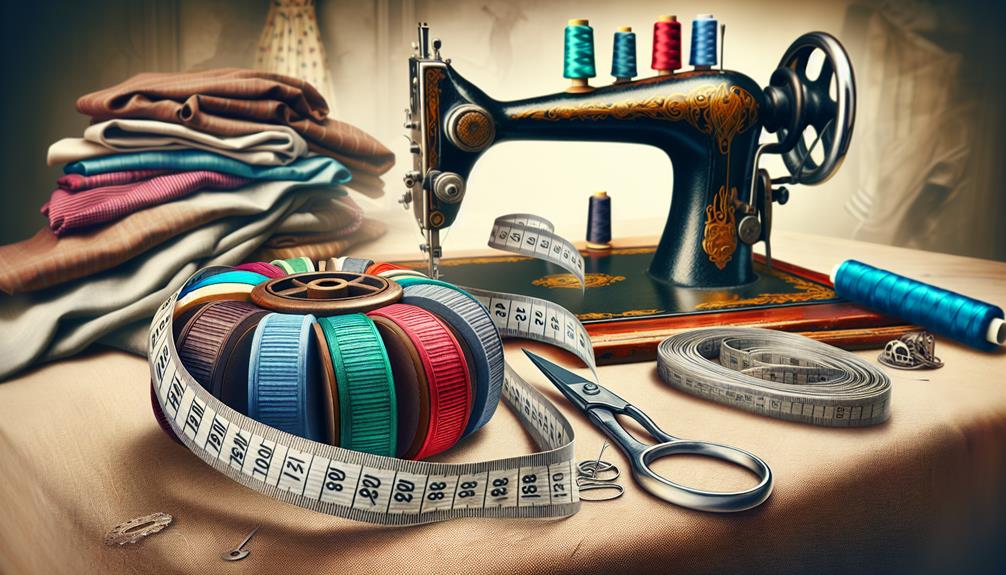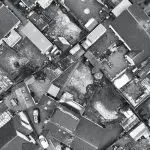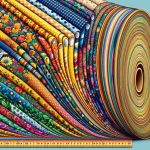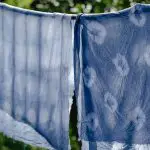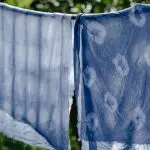In the world of shirt-making, determining the yardage of fabric needed is like exploring uncharted waters; one wrong measurement can leave you high and dry.
Imagine setting sail with just enough provisions to reach your destination, only to find yourself stranded mid-voyage.
Curious how many yards it takes to craft the perfect shirt? Let's unravel this fabric mystery together, stitch by stitch, to make sure your next project sets sail smoothly.
Table of Contents
Key Takeaways
- Calculate fabric yardage based on shirt specifications and adjustments.
- Optimize fabric layout for efficient usage and pattern alignment.
- Ensure extra fabric for pattern matching and design integrity.
- Consider customizations and consult professionals for tailored projects.
Calculating Fabric Yardage for a Shirt
To accurately determine the fabric yardage needed for a shirt, consider the average requirement of 2.5 yards, factoring in specific measurements like sleeve lengths and extra fabric for intricate parts.
When dealing with fabrics less than 150 cm wide, it's important to double the body length and add the sleeve length, especially for chest widths exceeding 130 cm. This adjustment guarantees you have ample fabric to work with.
Additionally, paying attention to the length of the fabric is vital to avoid running short. Making sure that you have enough fabric for small parts like collars and cuffs is also a key consideration.
Understanding Fabric Patterns and Layout
When working with fabric patterns, it's essential to contemplate how they align to avoid running short on yardage.
Understanding the importance of fabric grain and pattern matching can make a significant difference in the final look of your garment.
Efficient layout strategies can help maximize your fabric usage and guarantee a well-executed design.
Pattern Matching Tips
Understanding fabric patterns and layout involves careful consideration of how patterned fabrics like stripes and checks require extra fabric for precise alignment during cutting and sewing. When working with these fabrics, ensuring pattern matching is important for a professional finish.
Larger patterns generally demand more extra fabric to align correctly than smaller ones. For instance, narrow stripes may need less additional fabric for alignment purposes. Ordering sufficient yardage when dealing with patterned fabrics to accommodate for matching and layout requirements is necessary.
Fabric Grain Importance
Grasping the significance of fabric grain is fundamental in achieving precise pattern alignment and ultimate drape when crafting shirts. Understanding fabric patterns is key for optimizing fabric usage and ensuring the quality of the final product.
Here are three essential points to take into account when working with fabric grain:
- Alignment Precision: Properly aligning the fabric grain with the pattern pieces is vital for maintaining the intended design and fit of the shirt.
- Drape Enhancement: Fabric grain influences how the fabric falls and moves, impacting the overall drape of the shirt and enhancing its aesthetic appeal.
- Quality Assurance: Adhering to fabric grain guidelines ensures a professional finish, preventing distortion and ensuring that the shirt retains its intended shape and structure.
Layout Efficiency Strategies
Exploring efficient fabric layout strategies maximizes the use of material and minimizes waste when cutting pattern pieces for a shirt. When working with patterned fabrics like stripes or checks, it's important to take into account the extra fabric needed for pattern alignment. Larger patterns often require more additional yardage than narrower stripes, adding complexity to the cutting process. Careful fabric ordering is essential to make sure patterns match seamlessly for a polished final look.
Factors Affecting Fabric Yardage
When it comes to determining fabric yardage for making a shirt, factors like the fabric type and shirt size play a critical role.
Understanding how different fabrics drape and behave can impact the amount needed, while considering the size of the shirt guarantees a proper fit.
These factors are key in making sure you have the right amount of fabric to create your desired garment.
Fabric Type Impact
Understanding how different fabric types impact the yardage required for making a shirt is essential for accurate estimation and efficient planning. When considering fabric type, factors such as the amount of fabric and the width of the fabric play an important role in determining the total yardage needed.
Here are three key points to keep in mind:
- Density: Denser fabrics like denim typically require less yardage due to their weight and structure, while lightweight fabrics such as chiffon may necessitate more yardage for a shirt.
- Stretch: Fabrics with stretch properties like jersey may need less yardage because of their elasticity and ability to conform to the body, reducing the overall amount required.
- Pattern: Patterned fabrics often require extra yardage to assure proper pattern alignment and matching, impacting the total fabric needed for the shirt.
Shirt Size Consideration
Considering the size of the shirt plays a significant role in determining the required fabric yardage, especially for larger sizes. Various factors such as sleeve length, collar size, and body width impact the amount of fabric needed to make a shirt. Shirts designed for larger individuals or with specific details may necessitate extra yardage to guarantee a proper fit.
It's vital to include all components like cuffs, collars, and plackets in the calculations for fabric yardage. Accurate measurements and attention to design specifics are essential for accurately estimating the fabric yardage required to make a shirt. By carefully considering the shirt size and its unique requirements, you can make sure that you have the right yard of fabric to create a well-fitted garment.
Tips for Efficient Fabric Cutting
To efficiently cut fabric for sewing, strategic placement of pattern pieces on the fabric is key to minimizing waste and optimizing usage. Here are some tips for efficient fabric cutting:
- Utilize Cutting Layouts: Sewing patterns often provide cutting layouts that show the most efficient way to lay out pattern pieces on the fabric. Following these layouts can help you reduce scraps and make the most out of your fabric.
- Consider Fabric Grain and Pattern Direction: When placing pattern pieces on the fabric, pay attention to the fabric grain and the direction of the pattern. This consideration guarantees that your garment will drape properly and that patterns align correctly.
- Invest in Quality Cutting Tools: Quality cutting tools such as rotary cutters and cutting mats can make the cutting process more precise and efficient. These tools help you achieve clean cuts and accurate shapes, ultimately saving you time and fabric in the long run.
Converting Measurements for Different Shirt Styles
Efficient fabric cutting sets the foundation for accurately converting measurements for different shirt styles, ensuring the best fabric usage and minimal waste. When determining the yardage needed for various shirt styles, it is essential to take into account not only the main body pieces but also the additional fabric required for small parts like collars, cuffs, and pattern matching. Different shirt styles may demand varying amounts of fabric, with men's dress shirts typically needing around 2.5 to 3 yards of fabric. The table below illustrates how the width of the fabric influences the yardage required for a men's dress shirt:
| Fabric Width (inches) | Yards Needed for Men's Dress Shirt |
|---|---|
| 36 | 3 |
| 45 | 2.5 |
| 60 | 2 |
Understanding the relationship between fabric width and shirt width is vital for accurate yardage calculations. Always contemplate adding a bit of extra fabric to accommodate these small components and any customizations.
Adjusting Yardage for Customizations
When customizing a shirt, remember to account for additional yardage needed to accommodate design modifications such as added length or unique collars. Here are three key considerations to keep in mind when adjusting yardage for customizations:
- Special Collars: If you plan to add a unique collar style to your shirt, make sure to allocate extra fabric to guarantee there's enough material to execute the design properly. Intricate collar designs may require more fabric than a standard collar, so factor this into your yardage calculations.
- Added Length: Increasing the length of a shirt, whether for a tunic-style design or a specific look, will necessitate additional yardage. Measure the desired length accurately and adjust your fabric requirements accordingly to prevent running short on material for the front and back of the shirt.
- Email Address: Consider customizations like contrast cuffs, plackets, or yokes that can impact fabric requirements. If you have specific design elements in mind, consult the shirt pattern instructions or a professional tailor to determine the exact yardage needed for your custom shirt project. Remember to factor in any intricate details or design modifications to guarantee you have ample fabric for your unique creation.
Frequently Asked Questions
How Much Fabric Do I Need to Make a Shirt?
To make a shirt, I typically need around 2.5 yards of fabric. Sleeves require about 0.75 yards each, and I account for collar and cuff fabric. Consider width, pattern, and print direction for accurate yardage.
How Many Yards Do You Need to Make a T-Shirt?
To make a t-shirt, I usually need about 1 to 1.5 yards of fabric. Depending on the size and design, I might require up to 2 yards. It's smart to have extra for matching patterns or fixing mistakes.
Is 1 Yard of Fabric Enough for a Shirt?
No, 1 yard of fabric is usually not enough for a complete shirt. The average adult size shirt requires around 2.5 yards. Larger sizes or specific designs may need more fabric. Consider pattern details for accurate measurements.
How Many Yards Is an XL Shirt?
Making an XL shirt typically requires 2.5 to 3 yards of fabric, depending on the fabric width and design complexity. It's essential to contemplate these factors for accurate measurements. I recommend checking the pattern or using a fabric calculator for precise estimates.
- Tetron Fabric for Marine Applications: Durability and Use Cases - June 18, 2025
- Tetron Fabric for Outdoor Furniture: Weather Resistance and Care - June 18, 2025
- Tetron Fabric for Wall Coverings: Style and Application Tips - June 18, 2025

